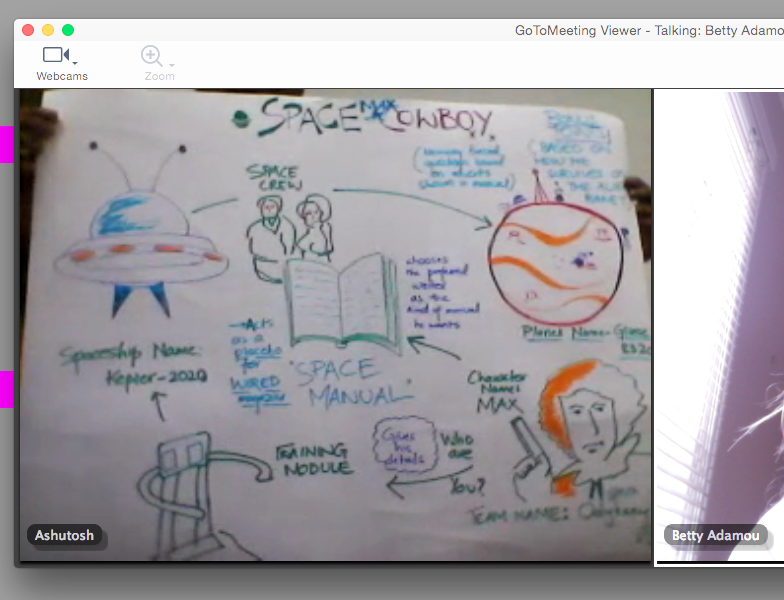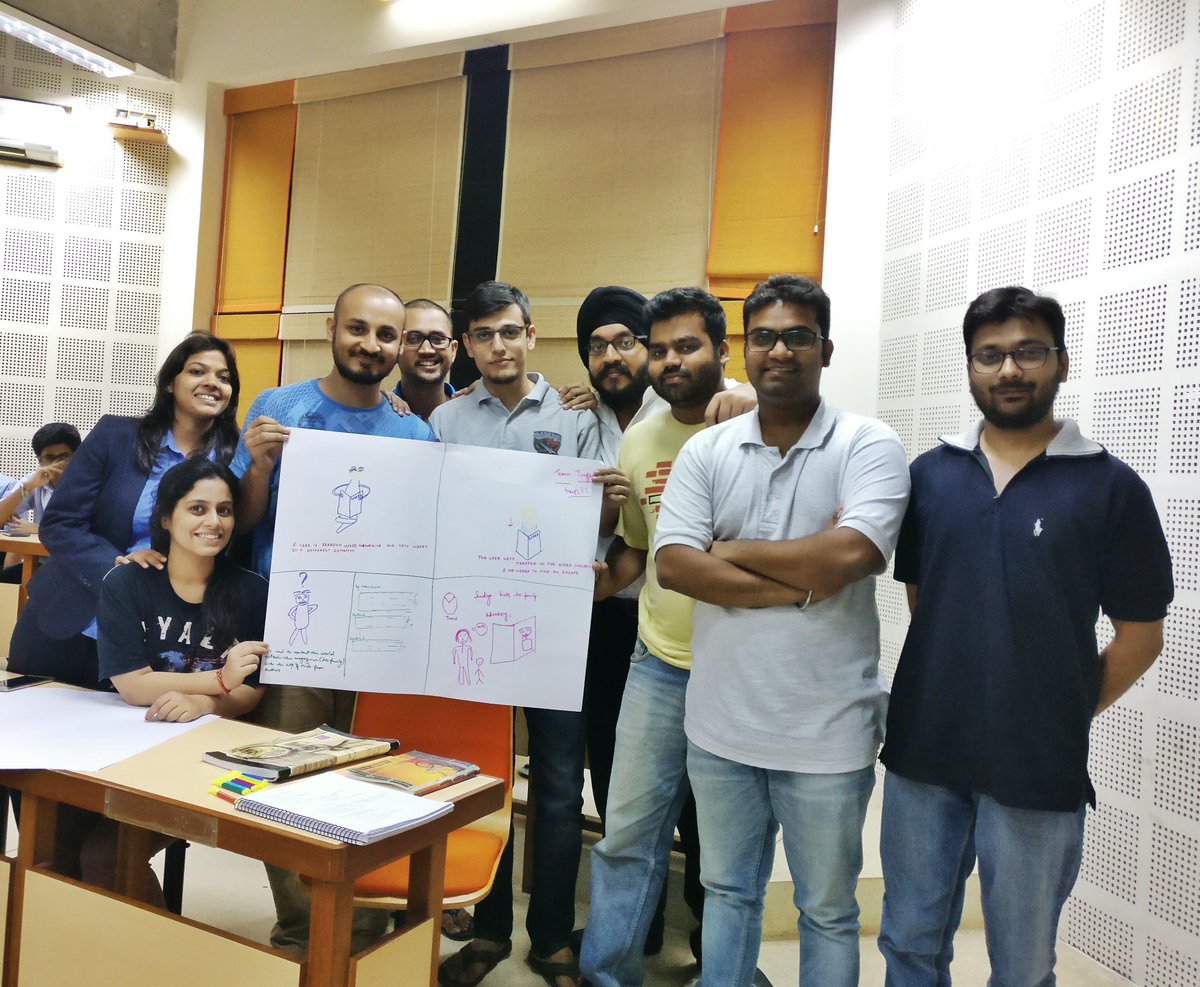Last week on Friday 2nd September I was delighted to have presented an activity-lead guest lecture via webinar to the talented and bright students at MICA University in India; a world-renowned University whose alumni (or MICAns, as they are known) have held and and in some cases still hold some of the most prestigious roles in the marketing and market research industry; from the Director of Marketing at Starbucks, the VP of Ogilvy & Mather, SVP to Datamatics Global Services, to Market Research & Insights heads at SABMiller and Microsoft.
But I’m not being nice about the students and the University because they invited me to speak there – rather, the ‘talented and bright’ description of the students comes from the levels of creativity, problem-solving and application of the understanding of game-based research methods that all the students displayed during the webinar and activities.
So what did the students do? The students got to storyboard their very own ResearchGame to what would have been an old client brief (and not one of RTG’s). Using an old survey that was produced on behalf of a well-known brand that was sent to me as a research participant a number of years ago (the survey was so dire I couldn’t complete the whole thing) I used this as the basis of what I call the ’20 for 20 game’; designing a 20 minute ResearchGame in 20 minutes.
The challenge was this: can the students make the original survey more engaging than the (experienced, well-paid and trained) researchers, by designing it as a game, in 20 minutes? I’m pleased to say the students met and exceeded that challenge. As such, the students produced a more engaging survey than the professional researchers who created the original.

Another MICA team presenting an original, engaging ResearchGame idea which used projective techniques, avatars, and narratologically-relevant reward systems that were harmonious with the research content.
In the vast majority the students were able to harmoniously marry a relevant narrative with the core game mechanics (goals, rules and feedback systems) with the research content at hand, and crucially, they designed a GAME for online research purposes. They did not GAMIFY the existing survey. This means that through designing the research as a fully-fledged game, the students would be able to encourage users to play, as opposed to simply ‘take part‘. (If you want to know why play is important to us researchers in the realm of online data collection, as well as learn the differences in games and gamification for online research, you can check out this presentation here.)
The students were also showing that their designs totally driven by the research content and the type of research audience (which is CRUCIAL!) i.e. how would this game appeal to the research participants? What look and feel should be applied? What about the overall user experience and ‘flow’?- e.g. are the participants likely to access the ResearchGame via a PC, laptop or mobile phone, or all of the above equally? And other similar things to consider (I recently designed a new ResearchGame were colourblindness had to be taken into account).
In groups, each team had to designed their own ResearchGame, and we had so many different ResearchGame ideas! Thus proving once again that game-based research methodologies can be very flexible from a creative standpoint, while still upholding the research objectives.
Once their 20 minutes were up and they each presented their ResearchGame idea to me, I had chosen “Team Trap”, as the winners.
Through the narrative Team Trap created for their ResearchGame, and the activities involved in each level they designed, they were able to show how they could truly immerse the participant in the research content, adhere to all research objectives, create activities for data collection in the game (that if carried out through traditional surveying methods would have been extremely difficult), and of course, through such a design, the students would have likely intrinsically engaged the participants. But their design did more than that – the students not only designed a ResearchGame with a narrative that was relevant to the participants, client, and research content, but also made sure their game mechanics where also narratologically-relevant (i.e. providing narratologically-relevant rewards at the completion of each level and narratologically-relevant goals). Their idea was so interesting that I’m hesitant to share it, in case the students decide to develop their idea even further, which I sincerely hope they do. (After all, they were only given 20 minutes to come up with a design!).
Many congratulations to Team Trap who had shown real creative genius! I also love how they and the other teams created their ResearchGame designs while being inspired by other media: Movies, anime, art. As a ResearchGame designer, you just never ever stop soaking in creative inspiration around you because you will always need to apply it in your ResearchGame designs. And of course you must PLAY GAMES! While soaking in other media as a form of inspiration can be crucial for ideas on UX and UI, look and feel, layout and so on, playing other games can help keep you abreast of new technologies, how digital components are individually evolving and being used in combination (such as music and sound effects with on screen timers, as one small example) and of course help you to understand more and more the difference between playing and ‘just taking part’, and therefore understand those benefits of play that are crucial in market research (such as stimulation of the mind and increasing problem-solving abilities, are two examples).
I want to congratulate every student who was in that webinar – you did something many experienced and trained researchers have never done! And to the other students who one day may end up as the researchers who price our market research studies, process our data, design our survey software, analyse our data etc: you are the next generation of research creatives and research scientists, and I hope that you will all be using game-based research methods in the future – whether the world has moved on and is using VR and/or Augmented Reality by then or not, you can and will always be able to apply game-based research methods to online data collection.
Thank you MICA for having me there for the 3rd year in a row and I look forward to hearing how the ideas of the evolve!
FINAL NOTE: There were 60 students who sighed up to attend the webinar. A webinar that was essentially about online research. A webinar that is usually about a subject deemed to be terribly boring for students (and I have spoken to enough students and young people to know that in general, this is their perception of online research). But as I’ve seen time and time again, not only does game-based research engage the participant and even the client more than when traditional surveying methods are being used, but game-based research also engages the people who will be the NEXT generation of researchers, who today, are our students. While it’s lovely to get positive feedback from students, I want them to hear more about game-based research FROM OTHER PEOPLE to get them more inspired to design and experiment in this area. If you’re reading this and you have the ability to share something you’ve done in game-based research with students, then DO IT!
If you’re a University that would like to teach your students about Game-Based Research Methods, then get in touch with me directly: betty.adamou@researchthroughgaming.com
Got something to add? Use the comments section!


